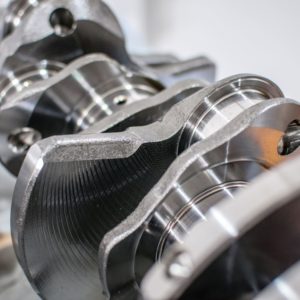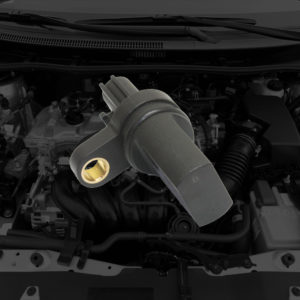The crankshaft position sensor (CKP) provides information to the powertrain control module (PCM) about the position and rotation speed of the crankshaft. If you think your vehicle’s CKP is faulty, you should connect a scan tool to check if a code, such as the P0385 code, has been stored.
What Does the P0385 Code Mean?
Diagnostic trouble code (DTC) P0385 stands for Crankshaft Position Sensor B Circuit Malfunction. If the powertrain control module doesn’t detect any signal or detects a faulty signal from the CKP sensor, then it will trigger the P0385 code.
The CKP sensor works by scanning the grooves of a reluctor ring using magnets. This reluctor ring is attached to the crankshaft so it spins at the same rate. Every time a groove passes over the CKP sensor, the magnetic field is interrupted, which then corresponds to signals sent to the PCM. The PCM is able to translate this into information on how fast the crankshaft is spinning as well as its position.

The PCM uses this information to determine ignition timing and sometimes other operating parameters, such as fuel injector control and variable valve timing operation. The signal from the CKP sensor is also used to monitor if there are any misfires in the cylinders.

Note: The definition of code P0385 might be different depending on the vehicle manufacturer. Consult the appropriate repair manual or repair database for the exact code definition.
What are the Common Causes of the P0385 Code?
The P0385 code may be caused by the following:
- Failed CKP sensor
- Damaged reluctor ring
- Faulty PCM
- Faulty wiring
What are the Common Symptoms of the P0385 Code?
Your vehicle might experience the following symptoms if the P0385 code is stored:
- Illuminated check engine light
- Engine runs rough or stalls
- Decreased engine performance
- The engine refuses to start

How to Diagnose the P0385 Code
The P0385 is a generic powertrain code that can be logged in most vehicles with an OBD-II system. While this code can be stored in most modern vehicles, remember that diagnosing this trouble code can vary depending on vehicle specifications.
The diagnostic process might require a visual inspection of the concerned parts, which can be difficult if you’re not familiar when it comes to the internal components of your vehicle. The CKP sensor itself might need to be tested, which requires the right tools. It might be best to have a trained mechanic do the job for you. However, you can also do it yourself if you’re confident in your DIY skills.
Interested in diagnosing your problem yourself? Learn about the diagnostic process below.
How to Fix the P0385 Code
The first thing you have to do before you start any repair process is a proper diagnosis. Accurately diagnosing the issue that’s triggering the code is important. Otherwise, you might be fixing or replacing a part that is functioning properly.
There are many ways to fix a specific OBD-II code because there are many possible causes. Once you’ve identified the issues causing the trouble code, then you can consult reliable online auto repair resources and how-to guides for possible fixes.
Since all vehicles are different, a fix for an OBD-II code for one vehicle may not work for another. Internal components can vary greatly among manufacturers. This is why you should consult a repair manual or repair database when it comes to troubleshooting and repairing DTCs. Chilton repair manuals can also be useful. An ALLDATA DIY subscription might be better, as it provides detailed factory repair information for drivers who want to do the repairs themselves.
Get a Replacement Crankshaft Position Sensor Today
Once you’ve successfully diagnosed the P0385 code, you can now take the necessary steps to replace the failed CKP sensor behind it. Ignoring the issue for too long can lead to an engine that runs rough, stalls, or refuses to start. Luckily, you can save yourself from all that trouble by getting a brand-new CKP sensor from CarParts.com today.
Browse through our wide selection of high-quality CKP sensors, and enjoy a hassle-free shopping experience, thanks to our built-in vehicle selector and search filters. By entering your vehicle’s year, make, and model, you can easily find all the available CKP sensors that are compatible with your ride. If you need any help, don’t hesitate to reach out to our customer service team who are always happy to help you with your order 24/7.
Don’t wait until your faulty CKP sensor interferes with your engine performance before replacing it. Check out our selection of high-quality crankshaft position sensors at CarParts.com and order one for your vehicle today!
Any information provided on this Website is for informational purposes only and is not intended to replace consultation with a professional mechanic. The accuracy and timeliness of the information may change from the time of publication.















